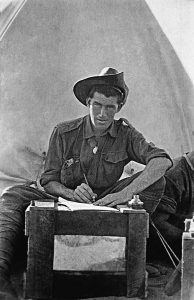
Sappers on deck the Orvieto – November 1914 (R.G. Casey album, National Archives of Australia)

A Turkish prisoner captured at Gallipoli July 1915 (R.G. Casey album, National Archives of Australia)
According to Anne-Marie Condé, World War I expert at the National Archives, “These diary excerpts help us experience, in a small way, what life was like for the men and women who answered the call.”
Perth artist Ellis Silas was one of the soldiers to commit his thoughts to paper on April 25 1915: “It was a magnificent spectacle to see those thousands of men rushing through the hail of Death as though it was some big game – these chaps don’t seem to know what fear means – in Cairo I was ashamed of them, now I am proud to be one of them though I feel a pigmy beside them.”
Thomas Ray Crooks, writing on August 6, 1915, expressed feelings of helplessness in the midst of turmoil: “The little hill above Taylor’s Gap was strewn with dead and badly wounded whose cries for ‘water water’ were pitiful. We had received orders before the assault that men wounded in the abdomen were not to be given water as it would do them more harm than good.”
Photographer Henry Charles Marshall, who was to die of wounds received at Gallipoli on June 10, 1915, had been working in the Grace Brothers photographic studio in Sydney when war was declared. Instead of writing a diary, Marshall captured his life as a soldier in detail through his camera lens.“Life Interrupted: Gallipoli moments”, based on a concept developed by the State Library of NSW, at the National Archives of Australia until November 15.
The post Voices from Gallipoli at the Archives appeared first on Canberra CityNews.
